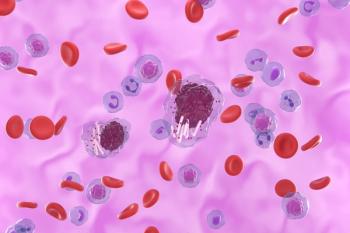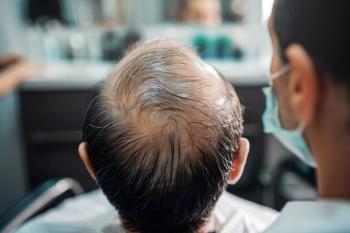
FDA Expands Dupilumab Approval as First New Biologic for Bullous Pemphigoid
Key Takeaways
- Dupilumab is now approved for bullous pemphigoid, showing efficacy in achieving sustained disease remission and reducing severity.
- The LIBERTY-BP ADEPT study demonstrated significant improvements in disease control and itch reduction with dupilumab.
Dupilumab was approved by the FDA to treat bullous pemphigoid, that demonstrated its efficacy in achieving sustained disease remission and significantly improving symptoms like itch and disease severity in adults.
The FDA expanded dupilumab's (Dupixent; Sanofi/Regeneron) approval to treat
Patients with bullous pemphigoid face an increased chance of infection, and the blisters and rash that can form over most of their bodies impact daily functioning, causing bleeding and scabbing.2 An estimated 27,000 adults in the US live with bullous pemphigoid that systemic corticosteroids do not control.3
“By addressing two central drivers of the underlying type 2 inflammation that contributes to bullous pemphigoid, Dupixent is the first targeted medicine to allow patients the potential to achieve sustained remission and reduce itch,” Alyssa Johnsen, MD, PhD, global therapeutic area head, immunology and oncology development at Sanofi said in a press release.1
Dupilumab, a fully human monoclonal antibody, inhibits the signaling of the IL-4 and IL-13 pathways, and it is not an immunosuppressant.2 In the US, the FDA has approved dupilumab for multiple indications, including atopic dermatitis, asthma, chronic rhinosinusitis with nasal polyposis, eosinophilic esophagitis, prurigo nodularis, and chronic obstructive pulmonary disease.4
Previously, the FDA granted dupilumab orphan drug designation, a process the agency developed for rare diseases.2 Earlier this year, the FDA accepted the supplemental biologics license application for dupilumab for priority review to treat adults with bullous pemphigoid.3
The FDA based its approval on results from the LIBERTY-BP ADEPT (
During oral corticosteroid treatment, researchers initiated tapering after patients experienced 2 weeks of sustained disease activity control. Oral corticosteroid tapering could begin and continue after 4 to 6 weeks of randomization if patients maintained disease control, with the intent to complete it by 16 weeks. Patients received only dupilumab or placebo after completing oral corticosteroid tapering for at least 20 weeks, unless rescue treatment became necessary.
Researchers defined sustained disease remission as complete clinical remission of oral corticosteroids tapered by 16 weeks without relapse and no rescue therapy use during the 36-week treatment period. They considered it a relapse when the appearance of 3 or more new lesions a month or 1 or more large lesions did not heal within a week.
Dupilumab achieved sustained disease remission in 20% of patients at 36 weeks, while only 4% of those receiving placebo reached this end point (P = .0114). Dupilumab's efficacy, when compared with placebo, included the absence of disease relapse after patients completed oral corticosteroid taper (59% vs 16%; nominal P = .0023), the absence of a need for rescue therapy during the treatment period (42% vs 12%; nominal P = .0004), and the achievement of complete remission and discontinuation of oral corticosteroids by week 16 (38% vs 27%; not significant).
For selected secondary end points, dupilumab demonstrated statistically significant results compared with placebo. Patients who received dupilumab achieved a 90% or greater reduction in disease severity (41% vs 10%; P = .0003) and a clinically meaningful itch reduction (40% vs 11%; P = .0006). Dupilumab also favored decreased oral corticosteroid use and extended time to rescue medication use, both of which were significant (P = .0220 and P = .0016, respectively).
Dupilumab outperformed placebo in reducing disease severity from baseline (77% vs 51%; P = .0021), reducing itch from baseline (52% vs 27%; P = .0021), and increasing days of complete remission off oral corticosteroids (40 vs 13; P = .0072).
Patients experienced overall adverse event (AE) rates of 96% (n = 51) with both dupilumab and placebo. For more than 3 patients, dupilumab showed AEs more commonly than placebo, including:
- peripheral edema (dupilumab vs placebo; 8 vs 5)
- arthralgia (5 vs 3)
- back pain (4 vs 2)
- blurred vision (4 vs 0)
- hypertension (4 vs 3)
- asthma (4 vs 1)
- conjunctivitis (4 vs 0)
- constipation (4 vs 1)
- upper respiratory tract infection (3 vs 1)
- limb injury (3 vs 2)
- insomnia (3 vs 2)
No AEs led to death in the dupilumab group, while 2 AEs caused death in the placebo group.
When the FDA reviewed the data, updated analyses at 36 weeks demonstrated that dupilumab improved outcomes compared with placebo.1 Specifically, 18.3% of patients on dupilumab achieved sustained disease remission vs 6.1% on placebo, representing a 12.2% difference.
Additionally, 38.3% of dupilumab patients experienced a clinically meaningful itch reduction compared with 10.5% with placebo, and the median cumulative oral corticosteroid dose was notably lower at 2.8 grams for dupilumab patients vs 4.1 grams for placebo.
In elderly patients, dupilumab treatment was associated with a higher incidence ( ≥ 2% ) of AEs compared with placebo, most commonly arthralgia, conjunctivitis, blurred vision, herpes viral infections, and keratitis. Additionally, 1 patient on dupilumab experienced acute generalized exanthematous pustulosis, a condition not observed in the placebo group.
"This approval further reinforces the demonstrated safety profile of Dupixent in a broad age range of patients, from infants to elderly people, and across dermatological, respiratory, and gastrointestinal diseases," George D. Yancopoulos, MD, PhD, board co-chair, president, and chief scientific officer at Regeneron Pharmaceuticals concluded in a press release.
References
1. Dupixent approved in the US as the only targeted medicine to treat patients with bullous pemphigoid. Press release. Sanofi; June 20, 2025. Accessed Jun 20, 2025.
2. Dupixent is the first and only biologic to achieve significant improvements in disease remission and symptoms in bullous pemphigoid positive pivotal study. Press release. Sanofi; September 11, 2024. Accessed June 17, 2025.
3. Dupixent sBLA accepted for FDA priority review for the targeted treatment of bullous pemphigoid. Press release. Sanofi; February 18, 2025. Accessed June 17, 2025.
4. Santoro C. FDA greenlights dupilumab for chronic spontaneous urticaria, marking first approval in a decade. AJMC®. April 18, 2025. Accessed June 17, 2025.
Newsletter
Stay ahead of policy, cost, and value—subscribe to AJMC for expert insights at the intersection of clinical care and health economics.









































